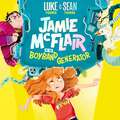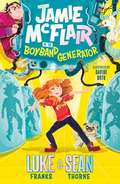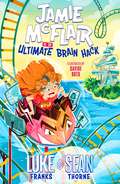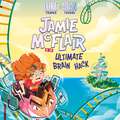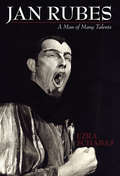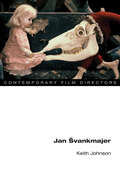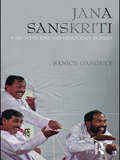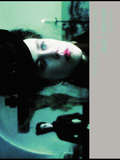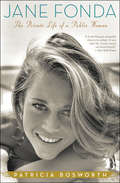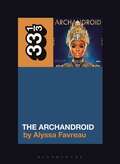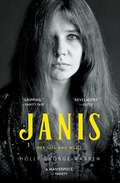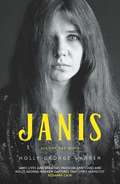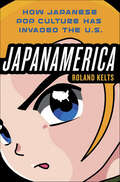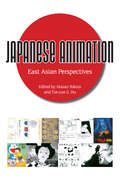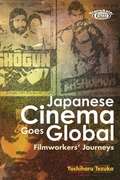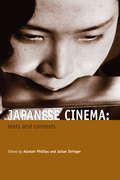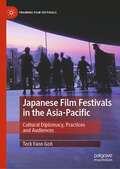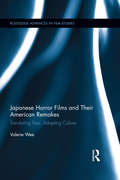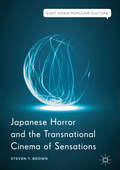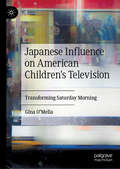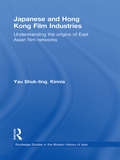- Table View
- List View
Jamie McFlair Vs The Boyband Generator: Book 1 (Jamie McFlair #1)
by Luke Franks Sean ThorneFour best friends, two boybands, and an evil uncle with a monstrous secret - what could possibly go wrong? KID NORMAL meets BRITAIN'S GOT TALENT in this hilarious new series for 8+ readers.This story begins with a snoring pug, a forgetful grandma, and the hero of this adventure in a really bad mood. There is also a goose on the loose. We just wanted to warn you.Jamie McFlair's favourite band got a slot performing on the country's biggest talent show, but it went wrong thanks to Barry Bigtime (in an 'incident' involving a chocolate milkshake and worn underpants - don't ask).Barry is a music big shot, all round nasty man...and Jamie's Uncle. The next day, he launches his own massive new band and Jamie smells a rat. With the help of three trusty best friends - popular Daisy, no-nonsense Jenners, and timid Mel - Jamie vows to uncover Barry's dastardly plan.But Jamie doesn't know about BARRY'S SECRET. A secret that is TERRIBLE and SHOCKING and VERY STRANGE. There's something hidden in Barry's basement - a machine that is the key to his musical success. But what happens when the boyband generator goes wrong? We'll give you a clue: it is NOT GOOD and THE ENTIRE WORLD is at risk. Can Jamie stop Barry Bigtime before it's too late?(P)2021 Hodder & Stoughton Limited
Jamie McFlair Vs The Boyband Generator: Book 1 (Jamie McFlair)
by Luke Franks Sean Thorne"Funny, zany, the right amount of cheeky and answers that BIG question - what is really going on with 'Boy Band hair?'" - Jenny Pearson, bestselling author of The Super Miraculous Journey of Freddie YatesFour best friends, two boybands, and an evil uncle with a monstrous secret - what could possibly go wrong? KID NORMAL meets BRITAIN'S GOT TALENT in this hilarious new series for 8+ readers.This story begins with a snoring pug, a forgetful grandma, and the hero of this adventure in a really bad mood. There is also a goose on the loose. We just wanted to warn you.Jamie McFlair's favourite band got a slot performing on the country's biggest talent show, but it went wrong thanks to Barry Bigtime (in an 'incident' involving a chocolate milkshake and worn underpants - don't ask).Barry is a music big shot, all round nasty man...and Jamie's Uncle. The next day, he launches his own massive new band and Jamie smells a rat. With the help of three trusty best friends - popular Daisy, no-nonsense Jenners, and timid Mel - Jamie vows to uncover Barry's dastardly plan.But Jamie doesn't know about BARRY'S SECRET. A secret that is TERRIBLE and SHOCKING and VERY STRANGE. There's something hidden in Barry's basement - a machine that is the key to his musical success. But what happens when the boyband generator goes wrong? We'll give you a clue: it is NOT GOOD and THE ENTIRE WORLD is at risk. Can Jamie stop Barry Bigtime before it's too late?
Jamie McFlair Vs The Ultimate Brain Hack (Jamie McFlair)
by Luke Franks Sean ThorneThe laugh-out-loud new adventure featuring Jamie McFlair, from comedy duo Luke and Sean. Packed full of illustrations, this is perfect for 8+ readers and fans of Kid Normal and The Great Dream Robbery.Welcome to a new adventure starring our courageous young heroine Jamie McFlair, who so successfully thwarted her nasty uncle's monstrous plans a few months ago. But as we rejoin her, Jamie McFlair is ... sad. HUH!? Well, she just found out that she and her best friends - Daisy, Mel, and Jenners - are being split up and sent to different schools. Not one to admit defeat, Jamie discovers a way out of this unpleasant situation: Rubbsling's Academy for Creators, a school for famous kids. Because of their antics stopping the evil mastermind Barry Bigtime, Jamie and her friends have attracted some fans. It's enough to get them accepted into the school - they can stay together!But the school is ... weird. Located on a remote island, with strange teachers who give out punishments for NOT having your phone out in class, it all seems geared towards building the students' social media profiles. Though Daisy enjoys the attention, Jamie is suspicious that something isn't right. What is really going on at this school?Poor Jamie. What she's about to discover is that Barry Bigtime is bigtime back. Fallen from grace, outcast by society, and determined for revenge on Jamie, the school is the secret hiding place for his new plan...A plan to control the brains of all the children at the school, to make them do what he wants. A plan that is the first step towards controlling EVERY BRAIN ON THE PLANET!What questionable science is this!? How will this madness end?! Can Jamie rescue her friends and defeat Barry Bigtime once more, or will she become victim to THE ULTIMATE BRAIN HACK?
Jamie McFlair Vs The Ultimate Brain Hack: Book 2 (Jamie McFlair #2)
by Luke Franks Sean ThorneWelcome to a new adventure starring our courageous young heroine Jamie McFlair, who so successfully thwarted her nasty uncle's monstrous plans a few months ago. But as we rejoin her, Jamie McFlair is ... sad. HUH!? Well, she just found out that she and her best friends - Daisy, Mel, and Jenners - are being split up and sent to different schools. Not one to admit defeat, Jamie discovers a way out of this unpleasant situation: Rubbsling's Academy for Creators, a school for famous kids. Because of their antics stopping the evil mastermind Barry Bigtime, Jamie and her friends have attracted some fans. It's enough to get them accepted into the school - they can stay together!But the school is ... weird. Located on a remote island, with strange teachers who give out punishments for NOT having your phone out in class, it all seems geared towards building the students' social media profiles. Though Daisy enjoys the attention, Jamie is suspicious that something isn't right. What is really going on at this school?Poor Jamie. What she's about to discover is that Barry Bigtime is bigtime back. Fallen from grace, outcast by society, and determined for revenge on Jamie, the school is the secret hiding place for his new plan...A plan to control the brains of all the children at the school, to make them do what he wants. A plan that is the first step towards controlling EVERY BRAIN ON THE PLANET!What questionable science is this!? How will this madness end?! Can Jamie rescue her friends and defeat Barry Bigtime once more, or will she become victim to THE ULTIMATE BRAIN HACK?(P) 2022 Hodder & Stoughton Limited
Jan Brett's The Nutcracker
by Jan BrettJan Brett's striking illustrations and the Christmas classic The Nutcracker are a match made in picture book heaven.When Marie and her brother Fritz receive a special Christmas nutcracker from their uncle, Marie immediately feels something magical. "He looks like a real boy," she mused. "A real boy with a secret, who came from far away." This feeling is only the beginning of the epic adventure she goes on with the Nutcracker—into the cabinet, through the battle with the mice, and finally to the magical land of the Sugar Plum Fairy. Jan Brett makes this classic her own by setting it in snowy Russia and adding whimsical touches to the favorite elements of the traditional ballet. Enjoying this book will be an instant Christmas tradition for families who love the ballet and those new to the story.As perfect a gift as Jan Brett's classics The Mitten and The Night Before Christmas.
Jan Rubes: A Man of Many Talents
by Ezra SchabasJan Rubes has been a leading performer and director on stage, film, and TV, and in concert, opera, musical comedy, and drama. With an operatic career already established, the Czechoslovakia native immigrated to Canada in 1949 and was soon the leading bass in the Canadian Opera Company. He has performed throughout Canada and the U.S. both with the company and in countless solo recitals and appearances with symphony orchestras. Rubes has done more than 100 operatic roles and has appeared in more than 70 films, including the well-remembered Witness with Harrison Ford. With his wife, Susan Douglas Rubes, he helped develop Young People’s Theatre in Toronto. A member of the Order of Canada and holder of two honourary doctorates, he has won Geminis for his film work. His life is rich in detail – he has been both a national tennis champion and an important part of the history of the performing arts in Canada.
Jan Svankmajer (Contemporary Film Directors)
by Keith Leslie JohnsonJan Svankmajer enjoys a curious sort of anti-reputation: he is famous for being obscure. Unapologetically surrealist, Svankmajer draws on the traditions and techniques of stop-motion animation, collage, montage, puppetry, and clay to craft bizarre filmscapes. If these creative choices are off-putting to some, they have nonetheless won the Czech filmmaker recognition as a visionary animator. Keith Leslie Johnson explores Svankmajer's work as a cinema that spawns new and weird life forms ”hybrids of machine, animal, and non-organic materials like stone and dust. Johnson's ambitious approach unlocks access to the director's world, a place governed by a single, uncanny order of being where all things are at once animated and inert. For Svankmajer, everything is at stake in every aspect of life, whether that life takes the form of an object, creature, or human. Sexuality, social bonds, religious longings ”all get recapitulated on the stage of inanimate things. In Johnson's view, Svankmajer stands as the proponent of a biopolitical, ethical, and ecological outlook that implores us to reprogram our relationship with the vital matter all around us, including ourselves and our bodies.
Jana Sanskriti (Routledge Performance Practitioners #24)
by Ralph YarrowRegarded by Augusto Boal as the international icon of his vision, Jana Sanskriti are the leading practitioners of Theatre of the Oppressed and Forum Theatre in India and the East. The group has worked continuously with rural communities in West Bengal since its beginnings in 1985 to reconfigure social and political relationships through theatre, achieving both a solid regional presence and an international reputation. This book combines: a biography of the group, charting their history, methodology and modes of operation an examination of Jana Sanskriti through the writings of their founder, Sanjoy Ganguly a detailed analysis of their performance events and practices, including the plays collected in Ganguly's Where We Stand (2009) practical exercises and games, taken from Jana Sanskriti's workshops and festivals. As a first step towards critical understanding, and as an initial exploration before going on to further, primary research, Routledge Performance Practitioners offer unbeatable value for today’s student.
Jana Sanskriti: Forum Theatre and Democracy in India
by Sanjoy GangulyJana Sanskriti Centre for the Theatre of the Oppressed, based in West Bengal, is probably the largest and longest lasting Forum Theatre operation in the world. It was considered by Augusto Boal to be the chief exponent of his methodology outside of its native Brazil. This book is a unique first-hand account - by the group's artistic director Sanjoy Ganguly - of Jana Sanskriti's growth and development since its founding in 1985, which has resulted in a national Forum Theatre network throughout India. Ganguly describes the plays, people and places that have formed this unique operation and discusses its contribution to the wider themes espoused by Forum Theatre. Ganguly charts and reflects on the practice of theatre as politics, developing an intriguing and persuasive case for Forum Theatre and its role in provoking responsible action. His combination of anecdotal insight and lucid discussion of Boal’s practice offers a vision of far-reaching transformation in politics and civil society.
Jane Austen (LIVES #6)
by Carol ShieldsBestselling, award-winning novelist writing about one of the most popular and enduring English novelists of all time.'Splendid ... a gem' LITERARY REVIEW'An excellent biography' MAIL ON SUNDAY'Shields on Austen offers up a delicious prospect. And we are not disappointed' SCOTSMANJane Austen was one of the world's most remarkable writers, whose characters are as alive today as they were two hundred years ago. Despite being one of the most perceptive writers about people and relationships, she never married and always lived with her parents and sister Cassandra.Perhaps unusual for women at that time, Jane Austen was acutely aware of the larger political and social world around her, but chose to focus her novels on the family as a microcosm through which to explore human nature.The prizewinning novelist Carol Shields gives us a beautifully written, perceptive look at the life of one of the finest and most popular English novelists of all time.
Jane Campion (Routledge Film Guidebooks)
by Deb VerhoevenJane Campion is one of the most celebrated auteurs of modern cinema and was the first female director to be awarded the prestigious Palme d'Or. Throughout her relatively short career, Campion has received extraordinary attention from the media and scholars alike and has provoked fierce debates on issues such as feminism, colonialism, and nationalism. In this detailed account of Jane Campion's career as a filmmaker, Deb Verhoeven examines specifically how contemporary film directors 'fashion' themselves as auteurs – through their personal interactions with the media, in their choice of projects, in their emphasis on particular filmmaking techniques and finally in the promotion of their films. Through analysis of key approaches to Campion's films, such as The Piano; In the Cut; Sweetie; An Angel at My Table; and Holy Smoke Deb Verhoeven introduces students to the passionate debates surrounding this controversial and often experimental director Featuring a career overview, a filmography, scene by scene analysis and an extended interview with Campion on her approach to creativity, this is a great introduction to one of the most important directors of contemporary cinema.
Jane Fonda: The Private Life of a Public Woman
by Patricia Bosworth“An irresistible biography of the accomplished, controversial actress whose roles on screen and off helped define a generation. Whether you love Jane Fonda or abhor her, Jane Fonda is a detailed and generous exploration not only of the contradictory world Fonda grew up in but of the many people who shaped her.” —Jeannette Walls, author of The Glass Castle Patricia Bosworth has gone beyond the image of an American superwoman to reveal a Jane Fonda more powerful and vulnerable than ever expected. Fonda emerged from a heartbreaking Hollywood family drama to become a ’60s onscreen ingénue and then an Oscar-winning actress. At the top of her game she risked all, rising up against the Vietnam War and shocking the world with a trip to Hanoi. While becoming one of Hollywood’s most committed feminists, she financed her husband Tom Hayden’s political career in the ’80s with exercise videos that began a fitness craze and brought in millions of dollars. Just as interesting is Fonda’s next turn, as a Stepford Wife of the Gulfstream set, marrying Ted Turner and seemingly walking away from her ideals and her career. Fonda’s multilevel story is a blend of the deep insecurity, magnetism, bravery, and determination that has fueled her inspiring and occasionally infuriating public life. “The definitive portrait of a woman conflicted, torn between ferocious ambition, family, and feminist causes.” —Gail Sheehy, author of Passages “The Private Life does Jane Fonda the service of making us remember why she was relevant in the first place: the movies. Bosworth’s thorough account of this wild, uniquely twentieth-century Hollywood life makes Jane Fonda the actress even more intriguing.” —San Francisco Chronicle
Janelle Monáe's The Archandroid (33 1/3 #159)
by Alyssa FavreauIn Janelle Monáe's full-length debut, the science fiction concept album The ArchAndroid, the android Cindi Mayweather is on the run from the authorities for the crime of loving a human. Living in 28th century Metropolis, Cindi fights for survival, soon realizing that she is in fact the prophesied ArchAndroid, a robot messiah meant to liberate the masses and lead them toward a wonderland where all can be free. Taking into account the literary merit of Monáe's astounding multimedia body of work, the political relevance of the science fictional themes and aesthetics she explores, and her role as an Atlanta-based pop cultural juggernaut, this book explores the lavish world building of Cindi's story, and the many literary, cinematic, and musical influences brought together to create it. Throughout, a history of Monáe's move to Atlanta, her signing with Bad Boy Records, and the trials of developing a full-length concept album in an industry devoted to the production of marketable singles can be found, charting the artist's own rise to power. The stories of Monáe and of Cindi are inextricably entwined, each making the other more compelling, fantastical, and deeply felt.
Janis: Her Life and Music
by Holly George-WarrenLonglisted for the 2020 Andrew Carnegie Medals for Excellence This blazingly intimate biography of Janis Joplin establishes the Queen of Rock & Roll as the rule-breaking musical trailblazer and complicated, gender-bending rebel she was.Janis Joplin’s first transgressive act was to be a white girl who gained an early sense of the power of the blues, music you could only find on obscure records and in roadhouses along the Texas and Louisiana Gulf Coast. But even before that, she stood out in her conservative oil town. She was a tomboy who was also intellectually curious and artistic. By the time she reached high school, she had drawn the scorn of her peers for her embrace of the Beats and her racially progressive views. Her parents doted on her in many ways, but were ultimately put off by her repeated acts of defiance. Janis Joplin has passed into legend as a brash, impassioned soul doomed by the pain that produced one of the most extraordinary voices in rock history. But in these pages, Holly George-Warren provides a revelatory and deeply satisfying portrait of a woman who wasn’t all about suffering. Janis was a perfectionist: a passionate, erudite musician who was born with talent but also worked exceptionally hard to develop it. She was a woman who pushed the boundaries of gender and sexuality long before it was socially acceptable. She was a sensitive seeker who wanted to marry and settle down—but couldn’t, or wouldn’t. She was a Texan who yearned to flee Texas but could never quite get away—even after becoming a countercultural icon in San Francisco. Written by one of the most highly regarded chroniclers of American music history, and based on unprecedented access to Janis Joplin’s family, friends, band mates, archives, and long-lost interviews, Janis is a complex, rewarding portrait of a remarkable artist finally getting her due.
Janis: Her Life and Music
by Holly George-WarrenIt&’s been said Janis Joplin was second only to Bob Dylan as the &‘creator-recorder-embodiment of her generation&’s mythology&’. But how did a middle-class girl from Texas become a &’60s countercultural icon? Janis&’ parents doted on her and promoted her early talent for art. But the arrival of a brother shattered the bond she had with her intellectual maverick of a father, an oil engineer. And her own maverick instincts alienated her from her socially conformist mother. That break with her parents, along with the rejection of her high school peers, who disapproved of her beatnik look and racially progressive views, and wrongly assumed she was sexually promiscuous, cemented her sense of herself as an outcast. She found her tribe with a group of offbeat young men a year ahead of her, who loved her intellectual curiosity, her passion for conversation, and her adventurous search for the blues. Although she never stopped craving the approval of her parents and hometown, she left Port Arthur at seventeen determined to prove she could be loved. She tried college twice, and dropped out both times. She ran off to California, but came back when her heavy drug use scared her into it. She almost signed up for a life as a domesticated, hang-the-curtains wife. But instead, during a second stint on the West Coast, she launched a career that would see her crowned the queen of rock and roll. What no one besides Holly George-Warren has captured in such intimate detail is the way Janis Joplin teetered between the powerful woman you hear in her songs and the little girl who just wanted to go home and feel emotionally safe there. The pain of that dichotomy fuelled her music – and ultimately killed her.
Japan: It's Now All Raw Fish
by Don MaloneyHumorist Don Maloney describes life as a Westener living in Japan.
Japanamerica: How Japanese Pop Culture Has Invaded the U.S.
by Roland KeltsContemporary Japanese pop culture such as anime and manga (Japanese animation and comic books) is Asia's equivalent of the Harry Potter phenomenon--an overseas export that has taken America by storm. While Hollywood struggles to fill seats, Japanese anime releases are increasingly outpacing American movies in number and, more importantly, in the devotion they inspire in their fans. But just as Harry Potter is both "universal" and very English, anime is also deeply Japanese, making its popularity in the United States totally unexpected. Japanamerica is the first book that directly addresses the American experience with the Japanese pop phenomenon, covering everything from Hayao Miyazaki's epics, the burgeoning world of hentai, or violent pornographic anime, and Puffy Amiyumi, whose exploits are broadcast daily on the Cartoon Network, to literary novelist Haruki Murakami, and more. With insights from the artists, critics, readers and fans from both nations, this book is as literate as it is hip, highlighting the shared conflicts as American and Japanese pop cultures dramatically collide in the here and now.
Japanese Animation: East Asian Perspectives
by Masao Yokota and Tze-yue G. HuJapanese Animation: East Asian Perspectives makes available for the first time to English readership a selection of viewpoints from media practitioners, designers, educators, and scholars working in the East Asian Pacific. This collection not only engages a multidisciplinary approach in understanding the subject of Japanese animation but also shows ways to research, teach, and more fully explore this multidimensional world. Presented in six sections, the translated essays cross-reference each other. The collection adopts a wide range of critical, historical, practical, and experimental approaches. This variety provides a creative and fascinating edge for both specialist and nonspecialist readers. Contributors' works share a common relevance, interest, and involvement despite their regional considerations and the different modes of analysis demonstrated. They form a composite of teaching and research ideas on Japanese animation.
Japanese Cinema Goes Global
by Yoshiharu TezukaJapan's film industry has gone through dramatic changes in recent decades, as international consumer forces and transnational talent have brought unprecedented engagement with global trends. With careful research and also unique first-person observations drawn from years of working within the international industry of Japanese film, the author aims to examine how different generations of Japanese filmmakers engaged and interacted with the structural opportunities and limitations posed by external forces, and how their subjectivity has been shaped by their transnational experiences and has changed as a result. Having been through the globalization of the last part of the twentieth century, are Japanese themselves and overseas consumers of Japanese culture really becoming more cosmopolitan? If so, what does it mean for Japan's national culture and the traditional sense of national belonging among Japanese people?
Japanese Cinema: Texts and Contexts (Critical Concepts In Media And Cultural Studies)
by Alastair Phillips Julian StringerJapanese Cinema includes twenty-four chapters on key films of Japanese cinema, from the silent era to the present day, providing a comprehensive introduction to Japanese cinema history and Japanese culture and society. Studying a range of important films, from Late Spring, Seven Samurai and In the Realm of the Senses to Godzilla, Hana-Bi and Ring, the collection includes discussion of all the major directors of Japanese cinema including Ozu, Mizoguchi, Kurosawa, Oshima, Suzuki, Kitano and Miyazaki. Each chapter discusses the film in relation to aesthetic, industrial or critical issues and ends with a complete filmography for each director. The book also includes a full glossary of terms and a comprehensive bibliography of readings on Japanese cinema. Bringing together leading international scholars and showcasing pioneering new research, this book is essential reading for all students and general readers interested in one of the world’s most important film industries.
Japanese Film Festivals in the Asia-Pacific: Cultural Diplomacy, Practices and Audiences (Framing Film Festivals)
by Teck Fann GohThis book represents the first in-depth research dedicated to examining the historical and contemporary developments of Japanese film festivals as sites of cultural diplomacy. It focuses on the proliferation, network and operation of Japanese Film Festivals (JFFs) in the Asia-Pacific from the late 1970s until 2020. Through case examples in Australia, Malaysia and Thailand, the book explores how the formation and recent developments of JFFs in the region reflect wider changes in the function of Japanese cultural diplomacy through films, particularly with the intensification of economic, cultural and diplomatic opportunities presented in this geopolitical space.
Japanese Horror Films and their American Remakes: Japanese Horror Films And Their American Remakes (Routledge Advances in Film Studies)
by Valerie WeeThe Ring (2002)—Hollywood’s remake of the Japanese cult success Ringu (1998)—marked the beginning of a significant trend in the late 1990s and early 2000s of American adaptations of Asian horror films. This book explores this complex process of adaptation, paying particular attention to the various transformations that occur when texts cross cultural boundaries. Through close readings of a range of Japanese horror films and their Hollywood remakes, this study addresses the social, cultural, aesthetic and generic features of each national cinema’s approach to and representation of horror, within the subgenre of the ghost story, tracing convergences and divergences in the films’ narrative trajectories, aesthetic style, thematic focus and ideological content. In comparing contemporary Japanese horror films with their American adaptations, this book advances existing studies of both the Japanese and American cinematic traditions, by: illustrating the ways in which each tradition responds to developments in its social, cultural and ideological milieu; and, examining Japanese horror films and their American remakes through a lens that highlights cross-cultural exchange and bilateral influence. The book will be of interest to scholars of film, media, and cultural studies.
Japanese Horror and the Transnational Cinema of Sensations (East Asian Popular Culture)
by Steven T. BrownJapanese Horror and the Transnational Cinema of Sensations undertakes a critical reassessment of Japanese horror cinema by attending to its intermediality and transnational hybridity in relation to world horror cinema. Neither a conventional film history nor a thematic survey of Japanese horror cinema, this study offers a transnational analysis of selected films from new angles that shed light on previously ignored aspects of the genre, including sound design, framing techniques, and lighting, as well as the slow attack and long release times of J-horror’s slow-burn style, which have contributed significantly to the development of its dread-filled cinema of sensations.
Japanese Influence on American Children's Television: Transforming Saturday Morning
by Gina O’MeliaJapanese Influence on American Children’s Television examines the gradual, yet dramatic, transformation of Saturday morning children’s programming from being rooted in American traditions and popular culture to reflecting Japanese popular culture. In this modern era of globalization and global media/cultural convergence, the book brings to light an often overlooked phenomenon of the gradual integration of narrative and character conventions borrowed from Japanese storytelling into American children’s media. The book begins with a brief history of Saturday morning in the United States from its earliest years, and the interaction between American and Japanese popular media during this time period. It then moves onto reviewing the dramatic shift that occurred within the Saturday morning block through both an overview of the transitional decades as well as an in-depth analysis of the transformative ascent of the shows Mighty Morphin Power Rangers, Pokémon, and Yu-Gi-Oh!.
Japanese and Hong Kong Film Industries: Understanding the Origins of East Asian Film Networks (Routledge Studies in the Modern History of Asia)
by Shuk-ting, Kinnia YauDrawing on first-hand materials collected from the Chinese and Japanese literature as well as interviews with more than twenty filmmakers and scholars Kinnia Shuk-ting Yau provides a solid historical account of the complex interactions between Japanese and Hong Kong film industries from the 1930s to 1970s. The author describes in detail how Japan’s efforts during the 1930s and 1940s to produce a "Greater East Asian cinema" led to many different kinds of collaborations between the filmmakers from China, Hong Kong and Japan, and how such development had laid the foundation for more exchanges between the cinemas in the post-war period. The period covered by the book is the least understood period of the East Asian film history. Filling the gaps surrounding one of the most important but least understood periods of Asian film history this books discusses facts and resources once obscured by controversial issues related to wartime affairs with new insights and perspectives. This book is an invaluable source of information for understanding how the current East Asian film networks came into existence by looking beyond conventional single-case studies and adopting a transnational perspective in tracing the connections between different film industries.
